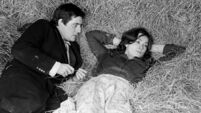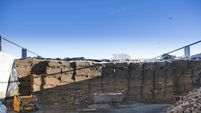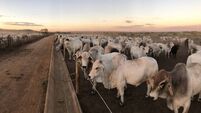Farm View: Red vs white clover - let's weigh up your options

Red clover may be nearly as good a feed crop as maize for intensive dairy or beef.
Red clover swards sound like the perfect solution, as the rising price of fertiliser adds huge costs to Ireland's grass-based farming.
In Teagasc trials, red clover and perennial ryegrass sward without nitrogen fertiliser yielded 13 to 16 tonnes per hectare of dry matter, which is about the same yield as perennial ryegrass getting 600 kg per hectare of nitrogen.
With these figures, red clover may be nearly as good a feed crop as maize for intensive dairy or beef. However, there isn't much experience growing it in Ireland. According to Teagasc, it may be out of favour here because of farmers' fear of the unknown.
In contrast, it is often used on mixed arable and grassland farms in England and Belgium. Now, the changed situation with fertiliser may force farmers to switch to red clover for silage.
Teagasc recommends a red clover sward for a first cut silage cut in mid-May, and then at six or seven-week intervals. The advice is to cut silage at 5-6 cm, and carry out a 48-hour wilt or use an effective preservative. The sward must be zero-grazed or grazed with lighter stock such as heifers, in October or November.
According to Nicky Byrne, Research Officer in Teagasc Grange, paddocks at Grange should yield 15-16 tonnes of dry matter per hectare in three cuts of silage, from slurry and P & K compound, without applying chemical nitrogen, because red clover is nitrogen-fixing.
However, red clover silage's productivity depends on the longevity of the sward, which can be improved by not using any nitrogen fertiliser, applying enough K fertiliser and lime, avoiding damage by machinery and grazing cattle, and post-emergence dock control after reseeding.
A per acre reseed pack should have 3-4kg of red clover, 6-9 kg of ryegrass, and 1 kg of white clover.
White clover is more persistent and can be over-sowed to maintain a 10-year productive sward after red clover dies out of the sward three or four years after reseeding. This approach has the inbuilt four-year rotation break needed for disease control. Otherwise, sclerotinia and stem eelworm can damage the sward.
In fact, these diseases caused a widespread clover crop "sickness" in the UK in the 1970s and 1980s, which coincided with a large-scale transition to chemical fertiliser nitrogen use, leading to red clover going somewhat out of fashion. There were also problems with stem eelworm on dairy farms in Denmark in the late 2000s.
But the risk of stem eelworm and sclerotinia crop diseases is low for the time being in Ireland, according to Teagasc, if there is a four-year break between red clover crops, and disease-resistant cultivars are sown.
Farmers may also fear the risk of bloat caused by grazing red clover, but that is not a risk with red clover silage, according to Teagasc. It also has a high oestrogen content, which may be linked with lower conception rates in breeding ewes.
High-K silage (more than 2.5% K) increases the risk of milk fever, but inadequate K shortens the longevity of red clover swards. Something else to watch out for is the greater challenge in making high-quality silage from a red clover sward.
Much lower water-soluble carbohydrates (81 versus 213) and higher buffering capacity (472 versus 415) make clover silage more difficult to ensile, compared to ryegrass. Therefore, wilting or an effective preservative is needed. In Teagasc trials, 48-hour wilting worked well. But the verdict was that a third cut can be risky, and there is no hope of ensiling a fourth cut.
Compared to ryegrass silage, when red clover is included, digestibility was lower (74 versus 81) in Teagasc trials. Crude protein was similar. Higher dry matter intake compensates for the lower digestibility; cows perform very well on red clover silage, once allowances are not restricted.
Red clover can suit intensive dairy farms with higher stocking rates on the grazing platform, and greater reliance on silage production from out-blocks. The 10% nitrogen cut for derogation farmers, and the trend to 20% lower fertiliser use in the new CAP also bring red clover into the picture.
For red clover, you must apply enough lime to bring soil pH to over 6.5, and there is also a very high requirement for potash (K). A good red clover silage crop takes out 375 kg/ha (300 units/acre) of K. Apply P and K compounds in accordance with soil test results. Index 1 soils need 25kg of K and 3kg of P for every tonne of dry matter per hectare expected, applied as organic manure or mineral fertiliser.
There are obvious challenges with clover, but strong possibilities also, in view of the rising cost of fertiliser.













